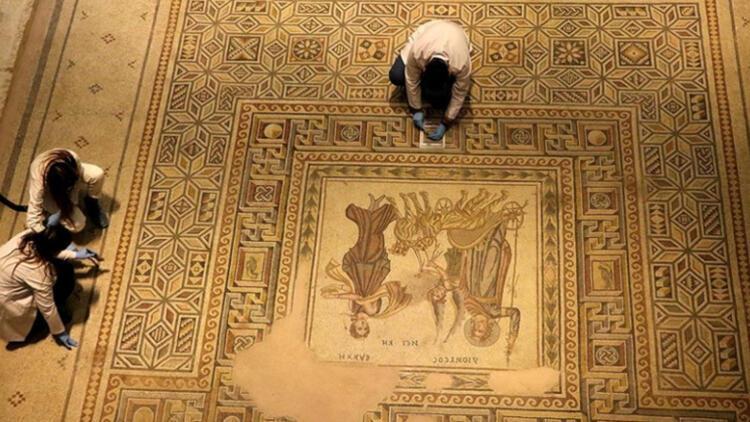
The unique mosaics in the Zeugma Mosaic Museum, one of the world’s largest mosaic museums located in Turkey’s southeastern province of Gaziantep, are being cleaned by an expert team with the utmost care and precision to protect them for future generations.
The world-famous mosaics in the museum, which are worthy of the Presidential Culture and Art Grand Prize, such as the “Gypsy Girl” mosaic, the “Mars statue,” the Roman fountains and other unique mosaics unearthed during the rescue excavations in the villas on the Euphrates River, are being protected by a team of eight experts of Gaziantep Restoration Conservation Regional Laboratories in an effort to preserve them for future generations.
Speaking to the state-run Anadolu Agency, Gaziantep Museums Director Özgür Çomak said that artworks in the museum were carefully looked after with proper checks conducted periodically to preserve and transfer them to future generations.
Çomak stated that the expert restorers of the Culture and Tourism Ministry have been carrying out technical works with proper techniques without damaging the artworks in any way.
“We carry out small, fine conservation and cleaning work without causing any damage to our artworks so that they reach our future generations. Just as we can see it today, we are carrying out this technical work in order to be able to see them after 100 years, too,” Çomak said.
Ayşe Ebru Çorbacı, the deputy director of the Gaziantep Restoration Conservation Regional Laboratories, which is affiliated with the Culture and Tourism Ministry’s General Directorate of Museums, said that they have been working to make the precious mosaics in the museum available for future generations.
Stating that the mosaics are checked periodically, Çorbacı said, “The artworks on display may have some dust or contamination. Therefore, our restorers are periodically checking these artworks at least three times a year to clean and conserve them.”
Noting that they try to intervene at the right time to check mosaics from deteriorating, Çorbacı said: “We carefully check the small stone pieces and mortars that form the mosaics to stop them from deteriorating with time. If there is such a risk, we make necessary applications to preserve and extend their life span a little more. We try to intervene at the right time in order to stop them from deteriorating any further.”
“There can be some problems due to visitors, but we take the necessary measures,” she added.
Noting that they make documents of the works conducted after they start with cleaning work in the first stage, Çorbacı said, “We do both photographic and written documentation.”
“We also document their materials. We look at the type of stone, colors used, deterioration levels and conditions of mortars. We find problems and make new mortar applications,” she added.
Stating that they are happy to work in the museum, which is home to the most important artworks in the world in terms of color and variety, Çorbacı said: “It is really important for us to see and document these mosaics. We have a very rich art in which glass tesserae and colored stones are used. It makes us happy to protect these works.”